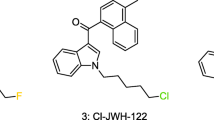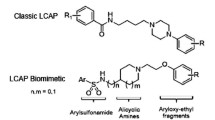Abstract
2,5-Dimethoxyphenethylamines and their N-benzylated derivatives are potent 5-HT2A agonists with psychedelic effects in humans. The N-benzylated derivatives are among the most selective 5-HT2A agonists currently available and their usage as biochemical and brain imaging tools is increasing, yet very little is known about the relationships between the structure of the ligands and their pharmacokinetic profile. In order to evaluate the potential of these compounds for in vivo applications we have determined the microsomal stability of 11 phenethylamines and 27 N-benzylated derivatives thereof using human liver microsomes. We found that the N-benzylated phenethylamines have much higher intrinsic clearance than the parent phenethylamines. We hypothesize that their low hepatic stability renders them orally inactive due to first pass metabolism, which is supported by anecdotal data from recreational use of these compounds.






Similar content being viewed by others
References
Schultes RE, Hofmann A (1979) Plants of the gods: origins of hallucinogenic use. Alfred van der Marck Editions, New York
Harman WW, McKim RH, Mogar RE, Fadiman J, Stolaroff MJ (1966) Psychedelic agents in creative problem solving: a pilot study. Psychol Rep 19:211–227
UNODC, World Drug Report (2013) United Nations publication, Sales no. E.13.XI.6
Vollenweider FX, Vollenweider-Scherpenhuyzen MF, Bäbler A, Vogel H, Hell D (1998) Psilocybin induces schizophrenia-like psychosis in humans via a serotonin-2 agonist action. Neuroreport 9(17):3897–3902
Griffiths RR, Richards WA, McCann U, Jesse R (2006) Psilocybin can occasion mystical-type experiences having substantial and sustained personal meaning and spiritual significance. Psychopharmacology 187(3):268–283
Griffiths R, Richards W, Johnson M, McCann U, Jesse R (2008) Mystical-type experiences occasioned by psilocybin mediate the attribution of personal meaning and spiritual significance 14 months later. J Psychopharmacol 22(6):621–632
Griffiths RR, Johnson MW, Richards WA, Richards BD, McCann U, Jesse R (2011) Psilocybin occasioned mystical-type experiences: immediate and persisting dose-related effects. Psychopharmacology 218:649–665
Grob CS, Danforth AL, Chopra GS, Hagerty M, McKay CR, Halberstadt AL, Greer GR (2011) Pilot study of psilocybin treatment for anxiety in patients with advanced-stage cancer. Arch Gen Psychiatry 68(1):71–78
Krebs TS, Johansen PØ (2012) Lysergic acid diethylamide (LSD) for alcoholism: meta-analysis of randomized controlled trials. J Psychopharmacol 26(7):994–1002
Moreno FA, Wiegand CB, Taitano EK, Delgado PL (2006) Safety, tolerability, and efficacy of psilocybin in 9 patients with obsessive-compulsive disorder. J Clin Psychiatry 67(11):1735–1740
Coyle JR, Presti DE, Baggott MJ (2012) Quantitative analysis of narrative reports of psychedelic drugs. arXiv:1206.0312v1
Nichols DE (2012) Structure–activity relationships of serotonin 5-HT2A agonists. WIREs Membr Transp Signal 1:559–579
Holmstedt B, Liljestrand G (1963) (eds) Readings in pharmacology. Macmillan, New York
Blaazer AR, Smid P, Kruse CG (2008) Structure-activity relationships of phenylalkylamines as agonist ligands for 5-HT(2A) receptors. ChemMedChem 9:1299–1309
Juncosa JI Jr, Hansen M, Bonner LA, Cueva JP, Maglathlin R, McCorvy JD, Marona-Lewicka D, Lill MA, Nichols DE (2013) Extensive rigid analogue design maps the binding conformation of potent N-benzylphenethylamine 5-HT2A serotonin receptor agonist ligands. ACS Chem Neurosci 4(1):96–109
Hansen M, Phonekeo K, Paine JS, Leth-Petersen S, Begtrup M, Bräuner-Osborne H, Kristensen JL (2014) ACS Chem Neurosci. doi:10.1021/cn400216u
Ettrup A, Hansen M, Santini MA, Paine J, Gillings N, Palner M, Lehel S, Herth MM, Madsen J, Kristensen J, Begtrup M, Knudsen GM (2011) Radiosynthesis and in vivo evaluation of a series of substituted 11C-phenethylamines as 5-HT (2A) agonist PET tracers. Eur J Nucl Med Mol Imaging 38(4):681–693
Ettrup A, Holm S, Hansen M, Wasim M, Santini MA, Palner M, Madsen J, Svarer C, Kristensen JL, Knudsen GM (2013) Preclinical safety assessment of the 5-HT2A receptor agonist PET radioligand [11C] Cimbi-36. Mol Imaging Biol 15(4):376–383
Gibbons S (2012) ‘Legal highs’-novel and emerging psychoactive drugs: a chemical overview for the toxicologist. Clin Toxicol (Phila) 50(1):15–24
Hill SL, Doris T, Gurung S, Katebe S, Lomas A, Dunn M, Blain P, Thomas SH (2013) Severe clinical toxicity associated with analytically confirmed recreational use of 25I-NBOMe: case series. Clin Toxicol (Phila) 51(6):487–492
http://www.erowid.org/chemicals/2cc_nbome/2cc_nbome_dose.shtml
Shulgin A, Shulgin A (1991) PIHKAL: a chemical love story. Transform Press, Berkeley
Carmo H, Hengstler JG, de Boer D, Ringel M, Remião F, Carvalho F, Fernandes E, dos Reys LA, Oesch F, de Bastos LM (2005) Metabolic pathways of 4-bromo-2,5-dimethoxyphenethylamine (2C-B): analysis of phase I metabolism with hepatocytes of six species including human. Toxicology 206(1):75–89
Kanamori T, Tsujikawa K, Ohmae Y, Iwata YT, Inoue H, Kishi T, Nakahama T, Inouye Y (2005) A study of the metabolism of methamphetamine and 4-bromo-2,5-dimethoxyphenethylamine (2C-B) in isolated rat hepatocytes. Forensic Sci Int 148(2–3):131–137
Carmo H, de Boer D, Remião F, Carvalho F, dos Reys LA, de Bastos LM (2004) Metabolism of the designer drug 4-bromo-2,5 dimethoxyphenethylamine (2C-B) in mice, after acute administration. J Chromatogr B Anal Technol Biomed Life Sci 811(2):143–152
Theobald DS, Maurer HH (2006) Studies on the metabolism and toxicological detection of the designer drug 2,5-dimethoxy-4-methyl-beta-phenethylamine (2C-D) in rat urine using gas chromatographic/mass spectrometric techniques. J Mass Spectrom 41(11):1509–1519
Theobald DS, Maurer HH (2006) Studies on the metabolism and toxicological detection of the designer drug 4-ethyl-2,5-dimethoxy-beta-phenethylamine (2C-E) in rat urine using gas chromatographic-mass spectrometric techniques. J Chromatogr B Anal Technol Biomed Life Sci 842(2):76–90
Kanamori T, Kuwayama K, Tsujikawa K, Miyaguchi H, Iwata YT, Inoue H (2011) Synthesis and identification of urinary metabolites of 4-iodo-2,5-dimethoxyphenethylamine. J Forensic Sci 56(5):1319–1323
Theobald DS, Staack RF, Puetz M, Maurer HH (2005) New designer drug 2,5-dimethoxy-4-ethylthio-beta-phenethylamine (2C-T-2): studies on its metabolism and toxicological detection in rat urine using gas chromatography/mass spectrometry. J Mass Spectrom 40(9):1157–1172
Theobald DS, Fehn S, Maurer HH (2005) New designer drug, 2,5-dimethoxy-4-propylthio-beta-phenethylamine (2C-T-7): studies on its metabolism and toxicological detection in rat urine using gas chromatography/mass spectrometry. J Mass Spectrom 40(1):105–116
Obach RS (2001) The prediction of human clearance from hepatic microsomal metabolism data. Curr Opin Drug Discov Devel 4(1):36–44
Chao P, Uss AS, Cheng KC (2010) Use of intrinsic clearance for prediction of human hepatic clearance. Expert Opin Drug Metab Toxicol 6(2):189–198
Rowland M, Tozer TN (1995) Clinical pharmacokinetics: concepts and applications, 3rd edn. Lippincott Williams & Wilkins, Media
Ma Q, Lu AY (2008) The challenges of dealing with promiscuous drug-metabolizing enzymes, receptors and transporters. Curr Drug Metab 9(5):374–383
Charalampous KD, Walker KE, Kinross-Wright J (1966) Metabolic fate of mescaline in man. Psychopharmacologia 9(1):48–63
Wager TT, Hou X, Verhoest PR, Villalobos A (2010) Moving beyond rules: the development of a central nervous system multiparameter optimization (CNS MPO) approach to enable alignment of drug-like properties. ACS Chem Neurosci 1(6):435–449
Conflict of interest
The authors declare no conflict of interest associated with the present study.
Author information
Authors and Affiliations
Corresponding author
Additional information
Special Issue: In honor of Krogsgaard-Larsen.
Rights and permissions
About this article
Cite this article
Leth-Petersen, S., Bundgaard, C., Hansen, M. et al. Correlating the Metabolic Stability of Psychedelic 5-HT2A Agonists with Anecdotal Reports of Human Oral Bioavailability. Neurochem Res 39, 2018–2023 (2014). https://doi.org/10.1007/s11064-014-1253-y
Received:
Revised:
Accepted:
Published:
Issue Date:
DOI: https://doi.org/10.1007/s11064-014-1253-y




